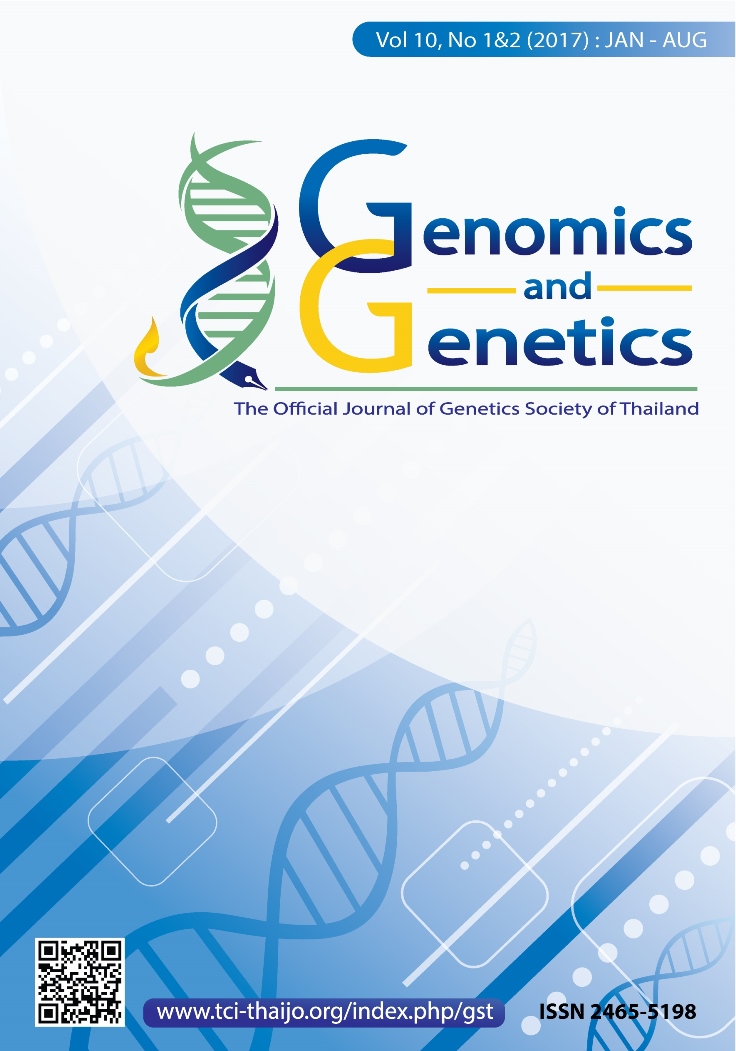Development of allele-specific SNP markers for PPR10 gene at Rf4 locus of Fertility Restorer Gene for Identification of Maintainer and Restorer lines
DOI:
https://doi.org/10.14456/gag.2017.6Keywords:
Allele-specific SNP marker, Tetra-primer amplification refractory mutation system-polymerase chain reaction (ARMS-PCR), Restorer of fertility (Rf) gene, Pentatricopeptide repeat (PPR) protein, Wild abortive- cytoplasmic male sterility (WA-CMS)Abstract
Cytoplasmic male sterility (CMS) -associated genes are located in mitochondrial genome whereas restorer of fertility (Rf) genes are located in nuclear genome. Two major restorer gene loci of Wild abortive-CMS (WA-CMS), Rf3 and Rf4, are required for the production of viable pollen. The Rf4 locus of indica rice cultivars were reported, which contains four RNA-binding pentatricopeptide repeat protein (PPR) encoding genes. Preliminary sequence analysis of reported PPR gene at Rf4 locus from maintainer and restorer lines revealed the difference in size of protein only PPR10 protein that resulted from single nucleotide polymorphism (SNP). In this study, PPR10 gene was isolated from four Thai rice cultivars by Polymerase Chain Reaction (PCR) of genomic DNA. The nucleotide sequences of cloned PPR10 gene from Khao Dawk Mali 105 and Nahng Mon S-4, Pathum Thani 1 and Suphan Buri 1 were analyzed by ClustalX program. One of fifteen SNPs at position 1,392 caused nonsense mutation and classified PPR10 protein into 2 groups by the length. Tetra-primer amplification refractory mutation system-polymerase chain reaction (ARMS-PCR) is fast, reliable and low cost. Then, four primers of ARMS-PCR were developed to use as allele-specific DNA marker, which is the first specific gene marker for Rf4 locus. The tetra- primer ARMS-PCR products of 5 maintainer cultivars and 4 restorer cultivars were G allele (416 bp) and T allele (242 bp), respectively. Therefore, tetra-primer ARMS-PCR could be allele specific PPR10 gene marker and used to identity maintainer and restorer Thai rice cultivars of WA-CMS. This allele-specific PPR10 gene markers will be used for germplasm genotyping and hybrid rice breeding program.
References
Cai J, QP Liao, ZJ Dai, HT Zhu, RZ Zeng, ZM Zhang, and GQ Zhang (2013) Allelic differentiations and effects of the Rf3 and Rf4 genes on fertility restoration in rice with wild abortive cytoplasmic male sterility. Biologia Plantarum 57: 274-80.
Chiapparino E, D Lee, and P Donini (2004) Genotyping single nucleotide polymorphisms in barley by tetra-primer ARMS–PCR Genome 47: 414-20.
El-Namaky Raafat, Saber Sedeek, Yonnelle Dea Moukoumbi, Rodomiro Ortiz, and Baboucarr Manneh (2016) Microsatellite-aided screening for fertility restoration genes (Rf) facilitates hybrid improvement. Rice Science 23: 160-64.
Fan Fengfeng, Nengwu Li, Jie Wang, Xingdan Liu, Jianfeng Liu, Yingguo Zhu, and Shaoqing Li (2015) Molecular marker-directed development of a novel cytoplasmic male sterile line in rice. Molecular Breeding 35: 212.
Huang Jian-Zhong, Zhi-Guo E, Hua-Li Zhang, and Qing-Yao Shu. (2014) Workable male sterility systems for hybrid rice: Genetics, biochemistry, molecular biology, and utilization. Rice 7: 13.
Hwang Seon-Kap, and Young-Mi Kim. (2000) A simple and reliable method for preparation of cross-contamination-free plant genomic DNA for PCR-based detection of transgenes. Journal of Biochemistry and Molecular Biology 33: 537-46.
Kazama Tomohiko, and Kinya Toriyama (2014) A fertility restorer gene, Rf4, widely used for hybrid rice breeding encodes a pentatricopeptide repeat protein. Rice 7: 28.
Kiani G (2015) Validation of SSR markers linked to restoring fertility (Rf) genes and genotyping of rice lines at Rf Loci. Journal of Agricultural Science and Technology 17: 1931-38.
Larkin M A, G Blackshields, NP Brown, R Chenna, P A McGettigan, H McWilliam, F Valentin, I . Wallace, A Wilm, R Lopez, et al. (2007) Clustal W and Clustal X version 2.0. Bioinformatics 23: 2947-48.
Medrano Ruan Felipe Vieira, and Camila Andréa de Oliveira (2014) Guidelines for the Tetra-Primer ARMS–PCR technique development. Molecular Biotechnology 56: 599-608.
Melonek Joanna, James D. Stone, and Ian Small (2016) Evolutionary plasticity of restorer-of-fertility-like proteins in rice. Scientific Reports 6: 35152.
Miah Gous, Mohd Y Rafii, Mohd R Ismail, Adam B Puteh, Harun A Rahim, Kh Nurul Islam, and Mohammad Abdul Latif (2013) A review of microsatellite markers and their applications in rice breeding programs to improve blast disease resistance. International Journal of Molecular Sciences 14: 22499-528.
Pantuli Suvit (2013) Selection Thailand rice varieties for maintainer lines and restore lines and improvement Thailand rice varieties for cytoplasmic male sterility lines. In Special project Bachelor of Science Program in Agriculture (Agronomy) Maejo University.
Pranathi K, BC Viraktamath, C. Neeraja, SM Balachandran, AS Hari prasad, P Koteswara Rao, P Revathi, P Senguttuvel, SK Hajira, CH Balachiranjeevi, et al. (2016) Development and validation of candidate gene-specific markers for the major fertility restorer genes, Rf4 and Rf3 in rice. Molecular Breeding 36: 145.
Tang H, D Luo, D Zhou, Q Zhang, D Tian, X Zheng, L Chen, and YG Liu (2014) The Rice Restorer Rf4 for wild-abortive cytoplasmic male sterility encodes a PPR protein that functions in reduction of WA352 transcripts. Mol Plant 7: 1497-1500.
Waza SA, and HK Jaiswal (2016) Identfication of elite grain quality restorers and maintainers for WA CMS lines of rice (Oryza sativa L.). SABRAO Journal of Breeding & Genetics 48: 145-53.



